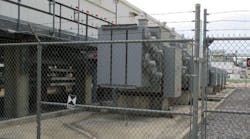Unlike residential and commercial installations, sometimes it’s difficult to determine the difference between a “service” and a “separately derived system” in an industrial setting. To better explain the difference between the two types of situations, let’s consider the following example.
A large refinery receives its power from the serving utility in three different locations through a total of six, 230kV transmission lines. These lines are owned by the utility. Each of the three 230kV switchyard locations is double ended — meaning that even though there are only three main substations, each substation contains switchgear that has an “A” bus and a “B” bus with a tie breaker between the two buses that can be used to transfer loads between them without interruption. Each of the six 230kV lines is derived from different utility substations further up the line. This electrical arrangement offers redundancy (having the double ended scheme) and less chance of downtime. Granted, if you go back up the line far enough, you’re probably going to see these individual transmission lines are on the same grid. However, the main power grid is highly reliable.
At each 230kV switchyard there are two 100MW transformers — one for the “A” bus and one for the “B” bus — stepping the voltage down to 34.5kV for distribution throughout the plant. The 100MW transformers are owned by the refinery. The “service point,” as defined in the National Electrical Code (NEC), is located at the 230kV terminals of the transformers. The service point is where the utility-owned conductors are connected to the customer-owned equipment or conductors. In this case, it just happens to be on the high-side terminals of the transformers.
The transformer secondary (34.5kV) conductors are metal-enclosed bus ducts. The bus bars connect to the secondary side of the 100MW transformers and are terminated in a substation nearby. Each bus duct terminates on a 2,000A, 34.5kV breaker. From the secondary side of the transformers to the line side of the 2,000A breakers, the bus ducts are considered to be “service conductors.” The 2,000A main circuit breakers are the “service disconnecting means.” NEC Art. 230 requirements apply up to the 2,000A breakers, even though the transformer and bus ducts are customer owned. The 2,000A circuit breakers are also considered part of the service equipment. The 2,000A service disconnecting means (main circuit breakers) in the 34.5kV switchgear feeds several vertical sections containing a mixture of 600A and 800A circuit breakers. All of this equipment is contained in the main substation. The 600A and 800A circuit breakers are the source of “feeders” as defined in NEC Art. 100.
The 34.5kV feeder conductors leave the main substation and feed switchgear in process unit substations around the refinery. The feeders terminate in a 34.5kV main breaker in switchgear located in each unit substation. From there, the 34.5kV power is distributed to various step-down isolation transformers at the unit substations. This part of the system also feeds 34.5kV loads in the process unit, such as large motors. Each transformer secondary in the unit substations is considered to be a separately derived system and is not subject to the requirements of NEC Art. 230.
In the example above, we actually only have a total of six services serving the premises. All circuits downstream are considered to be feeders, separately derived systems, and branch circuits.
© 2015 Fluor Corporation. All Rights Reserved.



